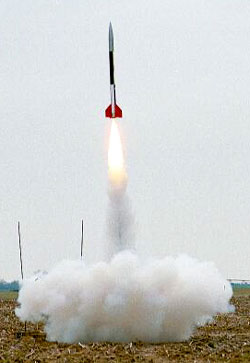| Manufacturer: | Yank Enterprises |

(Contributed - by Scott A. McCluskey)
 Brief:
Brief:
Built as a High Power rocket. Set up for dual deployment using altitude kit and
electronics.
Construction:
The airframe components for the 4" IRIS are one 36" flexible phenolic
tubes and one 28" flexible phenolic tube. The airframe for the booster
section comes pre-slotted for thru-the-wall attachment of the fins. There are 4
fins made of 1/4" Baltic Birch plywood. The two motor mount centering
rings are made of 1/4" Baltic Birch plywood. The motor mount is a extended
PML Quick Switch 2000 motor mount. The 24" 54mm tube is installed in the
IRIS with fittings to accept 29 and 38mm adapters. The shock cord is 20' of
9/16" tubular nylon. The nose cone is a 4" by 16.5" exposed
length plastic nosecone. An altitude package was installed for the dual
deployment recovery. The altitude kit consists of: 1 10" flexible phenolic
coupler, 2 - 1/4" threaded rods, 2 - 1/4" eyebolts, 2 -1/4"
Baltic Birch bulkheads, 1 - 1/4" Baltic Birch mounting ring, 1 - Baltic
Birch mounting plate, 15' of 9/16" tubular nylon, 1 - 108" rip-stop
nylon parachute replaced with a Rocketman R7C chute.
The instructions that come with the IRIS are very easy to follow. I have some pictures of the rocket as a kit and construction on my site (link button above). I decided to reinforce the kit with fiberglass cloth and epoxy to make it capable of flying with the larger Aerotech 54mm motors. To do this I wrapped the airframe and fins with 4 oz. and 3 oz. fiberglass cloth. I reinforced the motor mount with an additional centering ring and 2 lengths of 1/4 - 20 all-threads. I epoxied the fin can into the airframe using West System Epoxy 105 resin, 206 Hardener, and 406 Colloidial Silica. Once the epoxy dried I foamed the fin can with NHP Liquid Foam to make the fin can and airframe one single unit.
Finishing:
The IRIS is Red, White, Black and Silver. I used Peter Alway's Rockets of the
World to get the necessary scale information and paint scheme. I sprayed the
airframe with a basecoat of Krylon white. I painted the nose cone and upper
airframe with Krylon Silver and I painted the fins with Krylon red. I decided
to use Mono-Cote for the black in the roll pattern and it worked great!! I
wanted a scale look so I ordered scale ARC IRIS decals from Randy Brust at:
rocketgraphx@aol.com and they really
added to the look of the rocket. I would highly recommend Randy's decal
service.
Construction Rating: 5 out of 5
 Flight:
Flight:
Recommended motors are I-211, I-284, I-300, I-357, I-435, J-135, J-170H, J-180,
J-260H, J-275, J-350. I have flown the IRIS on a J350 and a 54mm long burn
K185. Both the J-350 and the K-185 flights used plugged motors and used
electronics and ejection charges for dual deployment recovery. I use Nomex®
cloth for recovery wadding and Aero-Pack motor retainers. The rocket flies very
straight and has flown to over 2000 ft. on a J-350 and to over 6000' on a
K-185.
Recovery:
Recovery is accomplished using dual deployment. The two sections separate at
apogee and are attached with the 20' of tubular nylon. I let the rocket fall
without a drogue until the programmed main parachute deployment altitude which
is determined by the electronics I am using on that flight. I have deployed the
main parachute at 400 ft. and 500 ft. The main Rocketman R7C chute is attached
to the upper section with 15' of tubular nylon. The IRIS is fairly easy to
prepare for flight and has recovered from all flights to date with no damage
other than some wear and tear.
Flight Rating: 5 out of 5
Summary:
I highly recommed the Yank 4" IRIS kit! The quality of the components and
the ease of building the rocket make the IRIS one of my favorite kit projects
to date.
I am planning on building the Yank 2" and 3" IRIS kits to add to my IRIS fleet.
Overall Rating: 5 out of 5
 |
 |